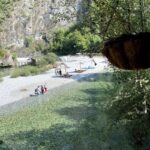According to the findings of archaeological digs, the beginning of the Koman material culture may be placed somewhere in the 7th or 8th century. The earliest signs of this civilization were uncovered in the area now known as Kalaja e Dalmâce, located inside the Koman settlement. The phenomenon was also observed to have extended to 30 other ancient sites in Kosovo and Albania. Archaeological evidence for this civilization is used to explain the link and transition from the Illyrian population to the arboreal one, according to the prevalent narrative in Albanian history. Many scholars from outside the country see this as evidence of a Romanized Illyrian people. Near the Dalmatian Castle in the Puka settlement of Koman in 1898, the French consul Alexander Degrand discovered a vast cemetery.
The consul recalled that he had come across a Pelasgian hamlet when he saw a large number of decorations and weapons in the graveyard. His findings are on exhibit at the Saint Germain des France pavilion dedicated to Koman culture. Afterward, researcher Paul Treger and Austro-Hungarian consul Theodor Ippen took over the excavations. The Berlin museum is home to Trager’s whole collection of findings.
Ugolini, an Italian archaeologist who worked in the region in the 1920s, conducted a thorough study of the artifacts unearthed in Koman, separating those with Celtic, Roman, and Byzantine roots from those from the “throw of peoples” era. Finds associated with the “Koman Culture” have emerged in recent years throughout South Albania and outside the limits of the country, in Montenegro, Kosovo, Macedonia, and Greece. “Koman culture” refers to the heritage of a people whose history spans the transition between the late antique and early medieval epochs, roughly between the years 600 and 800. The “Koman Culture” is linked to the ancient Illyrians who formerly lived in these territories because of the tombs’ typology, orientation, inventory of weapons, labor items, and decorations, and the presence of numerous components of Illyrian symbolism. Components of Illyrian continuity are present in “Koman Culture,” but there are also new elements from the early Byzantine era.
Throughout the depths of the Albanian territories, Byzantine influences and goods traveled via Durres, the most significant base of the Byzantine Empire in the west. These may be seen as belt buckles, gilded brooches, earrings, and other jewelry combinations. Above all else, however, the Byzantine legacy is felt in Christian symbols and aesthetics. Earrings featuring Christian prayers and formulae, peacock themes, and Eucharistic sceneries are all examples. Many of the ornaments unearthed from “Koman Culture” gravesites demonstrate the persistence of pagan themes, but the inclusion of Christian symbols demonstrates that the people who carried the “Koman Culture” had adopted, or was embracing, Christianity. The “Koman Culture” emerged in the rural interior of the country about the sixth and eighth centuries CE when Christianity expanded from metropolitan places like Durres, Shkodra, Ohrid, etc.It is only in the Middle Ages that the distinctive features of “Koman Culture,” including remnants of old Illyrian civilization, innovations from the early Byzantine era, and the unmistakable marks of the Christian religion, come into plain focus. Bearing this flag is a certain way to tell Albanians apart from their Slavic and Greek neighbors, both new and ancient.







